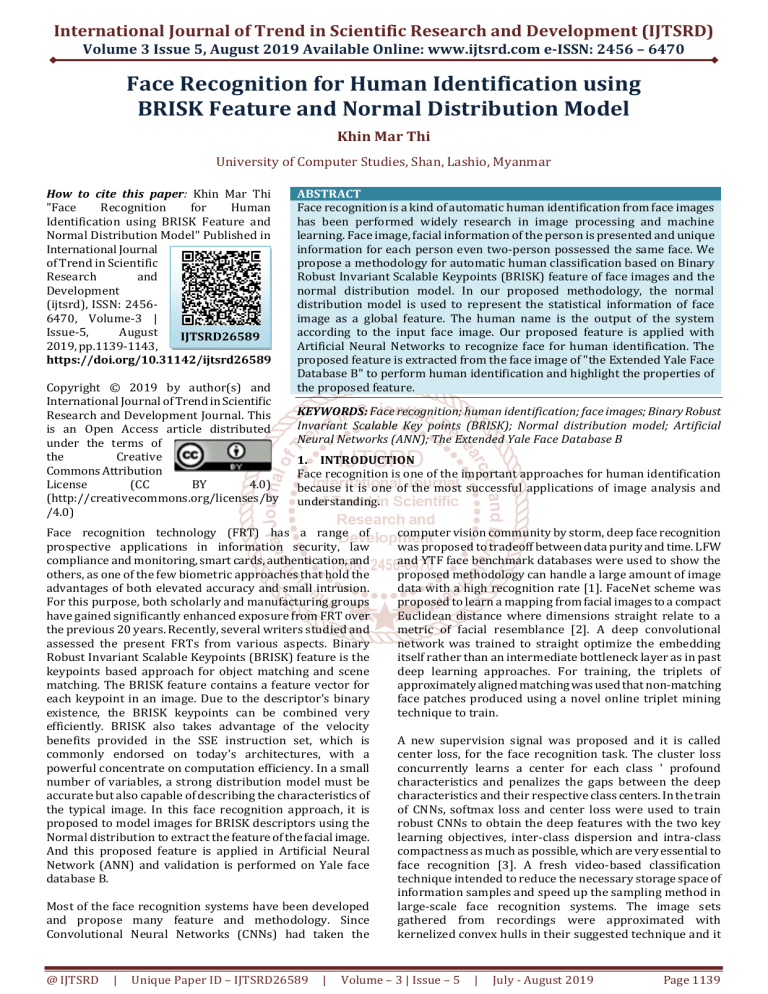
International Journal of Trend in Scientific Research and Development (IJTSRD)
Volume 3 Issue 5, August 2019 Available Online: www.ijtsrd.com e-ISSN: 2456 – 6470
Face Recognition for Human Identification using
BRISK Feature and Normal Distribution Model
Khin Mar Thi
University of Computer Studies, Shan, Lashio, Myanmar
How to cite this paper: Khin Mar Thi
"Face
Recognition
for
Human
Identification using BRISK Feature and
Normal Distribution Model" Published in
International Journal
of Trend in Scientific
Research
and
Development
(ijtsrd), ISSN: 24566470, Volume-3 |
Issue-5,
August
IJTSRD26589
2019, pp.1139-1143,
https://doi.org/10.31142/ijtsrd26589
Copyright © 2019 by author(s) and
International Journal of Trend in Scientific
Research and Development Journal. This
is an Open Access article distributed
under the terms of
the
Creative
Commons Attribution
License
(CC
BY
4.0)
(http://creativecommons.org/licenses/by
/4.0)
ABSTRACT
Face recognition is a kind of automatic human identification from face images
has been performed widely research in image processing and machine
learning. Face image, facial information of the person is presented and unique
information for each person even two-person possessed the same face. We
propose a methodology for automatic human classification based on Binary
Robust Invariant Scalable Keypoints (BRISK) feature of face images and the
normal distribution model. In our proposed methodology, the normal
distribution model is used to represent the statistical information of face
image as a global feature. The human name is the output of the system
according to the input face image. Our proposed feature is applied with
Artificial Neural Networks to recognize face for human identification. The
proposed feature is extracted from the face image of "the Extended Yale Face
Database B" to perform human identification and highlight the properties of
the proposed feature.
KEYWORDS: Face recognition; human identification; face images; Binary Robust
Invariant Scalable Key points (BRISK); Normal distribution model; Artificial
Neural Networks (ANN); The Extended Yale Face Database B
1. INTRODUCTION
Face recognition is one of the important approaches for human identification
because it is one of the most successful applications of image analysis and
understanding.
Face recognition technology (FRT) has a range of
prospective applications in information security, law
compliance and monitoring, smart cards, authentication, and
others, as one of the few biometric approaches that hold the
advantages of both elevated accuracy and small intrusion.
For this purpose, both scholarly and manufacturing groups
have gained significantly enhanced exposure from FRT over
the previous 20 years. Recently, several writers studied and
assessed the present FRTs from various aspects. Binary
Robust Invariant Scalable Keypoints (BRISK) feature is the
keypoints based approach for object matching and scene
matching. The BRISK feature contains a feature vector for
each keypoint in an image. Due to the descriptor's binary
existence, the BRISK keypoints can be combined very
efficiently. BRISK also takes advantage of the velocity
benefits provided in the SSE instruction set, which is
commonly endorsed on today's architectures, with a
powerful concentrate on computation efficiency. In a small
number of variables, a strong distribution model must be
accurate but also capable of describing the characteristics of
the typical image. In this face recognition approach, it is
proposed to model images for BRISK descriptors using the
Normal distribution to extract the feature of the facial image.
And this proposed feature is applied in Artificial Neural
Network (ANN) and validation is performed on Yale face
database B.
Most of the face recognition systems have been developed
and propose many feature and methodology. Since
Convolutional Neural Networks (CNNs) had taken the
@ IJTSRD
|
Unique Paper ID – IJTSRD26589
|
computer vision community by storm, deep face recognition
was proposed to tradeoff between data purity and time. LFW
and YTF face benchmark databases were used to show the
proposed methodology can handle a large amount of image
data with a high recognition rate [1]. FaceNet scheme was
proposed to learn a mapping from facial images to a compact
Euclidean distance where dimensions straight relate to a
metric of facial resemblance [2]. A deep convolutional
network was trained to straight optimize the embedding
itself rather than an intermediate bottleneck layer as in past
deep learning approaches. For training, the triplets of
approximately aligned matching was used that non-matching
face patches produced using a novel online triplet mining
technique to train.
A new supervision signal was proposed and it is called
center loss, for the face recognition task. The cluster loss
concurrently learns a center for each class ' profound
characteristics and penalizes the gaps between the deep
characteristics and their respective class centers. In the train
of CNNs, softmax loss and center loss were used to train
robust CNNs to obtain the deep features with the two key
learning objectives, inter-class dispersion and intra-class
compactness as much as possible, which are very essential to
face recognition [3]. A fresh video-based classification
technique intended to reduce the necessary storage space of
information samples and speed up the sampling method in
large-scale face recognition systems. The image sets
gathered from recordings were approximated with
kernelized convex hulls in their suggested technique and it
Volume – 3 | Issue – 5
|
July - August 2019
Page 1139
International Journal of Trend in Scientific Research and Development (IJTSRD) @ www.ijtsrd.com eISSN: 2456-6470
has been shown that it is adequate to use only the samples
involved in modeling the image establish boundaries in this
setting. The kernelized Support Vector Data Description
(SVDD) is used to obtain significant samples that shape the
limits of the picture set. A binary hierarchical decision tree
method was suggested to boot the classification accuracy
level [4].
The extraction of geometric and appearance feature was
proposed to identifier age and gender. In their feature
extraction approach, cumulative benchmark approach was
used. For gender clustering, both of supervise and
unsupervised approaches were used. While supervised
machine learning approach was used for gender
classification. To compare the performance of the classifier
with the proposed feature, SVM, neural network, and adobos
were used [5]. An extended kernel discriminant analysis
framework for Face Recognition is proposed based on Image
Set (FRIS) to overcome the problem of FRIS. To handle the
underlying non-linearity in data storage, an image set from
the original input space is mapped into model space and
described with Support Vector Domain Description (SVDD).
In model space, most of the mapped data is contained in a
hyper-sphere and the outliers are outside the hyper-sphere.
By researching an efficient information metric in model
space [6], a kernel function moves information from model
space to a high-dimensional feature speed.
2.1. Image Pre-processing
Image enhancement is performed to highlight the different
parts of the face in an image. Histogram equalization is
performed to enhance the contrast of images by
transforming the values in an intensity image so that the
histogram of the output image approximately matches a
specified histogram. The histogram equalization result of the
face image is shown in Figure 1.
(i). Input image (yaleB11_P08_Ambient.pgm)
According to these related work, several features, models,
machine learning algorithms and deep learning approaches
are proposed for face recognition. In our proposed
methodology, the key points of the face image are extracted
from the face image by BRISK keypoints generation
algorithm and then we derive the statistical values from
these extracted keypoints by normal distribution model. Our
proposed feature is derived from the combination of key
points based feature and probability distribution model
called BRISK and normal distribution. The extracted features
Yale face database B are trained by Artificial Neural Network
(ANN). The 10 Fold-cross validations are used for classifier
performance to show the advantages of proposed features.
(ii) Histogram of input image
There are four main sections of our paper. Introduction and
related works are presented in section 1. The proposed
methodology is presented in section 2. Experimental results
and dataset are described in section 3 and the conclusion is
presented in the final section.
2. Proposed Methodology
In the proposed methodology, there are three main steps:
pre-processing, feature extraction and recognition. Among
these steps, feature extraction is the main contribution of
this paper. In preprocessing, the output is the pre-processed
image for the input face image. The proposed features are
extracted from the pre-processed image and the Artificial
Neural Network is trained by using extracted proposed
features.
This section presents statistical information of BRISK feature
and how normal distribution fits with BRISK keypoints by
measuring Goodness of Fitting (GOF) test. The overview of
the BRISK feature and Normal distribution are also
presented in this section. The input to our proposed feature
extraction is the face image and the output is the name of the
person.
@ IJTSRD
|
Unique Paper ID – IJTSRD26589
|
(iii) Enhanced Image
(iv) Histogram of enhanced Image
Fig.1. Histogram equalization of the face image
Volume – 3 | Issue – 5
|
July - August 2019
Page 1140
International Journal of Trend in Scientific Research and Development (IJTSRD) @ www.ijtsrd.com eISSN: 2456-6470
In the histogram equalization process, the value of contrast
enhancement limit is 0.05 and creates a bell
bell-shaped
histogram of an input image for a more enhanced image
image.
2.2.
Binary Robust Invariant Scalable Keypoints
(BRISK)Feature
The intrinsic difficulty in extracting appropriate features
from an image resides in balancing two conflicting
objectives: high-quality
quality description and low computing
demands. In 2011, Leutenegger, Stefan, Margarita Chli, and
Roland Siegwart proposed BRISK methodology. To achieve
robustness and low computational cost for image feature
extraction. Among keypoints generation methods, BRISK
achieves the comparable
omparable quality of matching at much less
computation time. There are two main steps in BRISK
methodology: keypoints detection and keypoints
description. The keypoints detection step consists of [7]:
Generate scale space
Calculate FAST score using scale space.
Pixel level non-maximal suppression.
Calculate sub-pixel
pixel maximum across patch.
Calculate continuous maximum across scales.
Re-interpolate
interpolate image coordinates from scale space
feature point detection.
Given a set of keypoints (consisting of sub
sub-pixel refined
image locations and associated floating-point
point scale values),
the BRISK descriptor is composed as a bin
binary string by
concatenating the results of simple brightness comparison
tests. The keypoints description step consists of [9]:
Sample pattern of smoothed pixels around the feature.
Generate short-distance
distance pairs and long
long-distance pairs
for pairs of pixels
Calculate the local gradient between long
long-distance pairs.
Calculate total gradients to determine feature
orientation.
Rotate short-distance
distance pairs using orientation.
Generate binary descriptor from rotated short
short-distance
pairs.
While the Speed up Robust (SURF)
URF) descriptor is also
assembled via brightness comparisons, BRISK has some
fundamental differences apart from the obvious pre
pre-scaling
and pre-rotation
rotation of the sampling pattern. The BRISK
descriptor has Rotation invariant and scale
scale-invariant. The
BRISK feature
ture extraction is shown in Figure 2.
(ii)
BRISK key points of an image
Fig.2. BRISK key points of the face image
In Figure 2, there are 650 key points for the enhance Image
and the BRISK feature descriptor consists of 650x128
structure of a matrix for image information.
2.3. Normal Distribution Model
In the domain of statistics, the normal probability
distribution is really prevalent. When the height, weight,
wage, views or votes of people are measured, the resulting
result
graph is almost always a normal curve. The normal
distribution applies to a broad spectrum of events and is the
most commonly used distribution in statistics. It was initially
created as an estimate of the binomial distribution once the
amount of tests is big and the Bernoulli probability p is not
near to 0 or 1. It is also the exponential type of the total value
of random variables under a large variety of circumstances.
The normal distribution was first defined in 1733 by the
French mathematician De Moivre.
Moiv
The growth of the
allocation is most often attributed to Gauss, who introduced
the concept to the motions of celestial bodies [8]. The
probability density function of Normal distribution is:
f(x) =
σ( π)
(1)
μ)
(
σ
where f(x) is the distribution of x value, is the standard
deviation and is the mean. Thus for the normal distribution
the mean, μ, is a location parameter (the locating point is the
midpoint of the range) and the standard deviation, σ, is a
scale parameter.. The normal distribution does shape
parameter. In a normal distribution model, the method of
moments is used to estimate the two parameters of its
distribution.
(μ) = ∑
E σ
=
(2)
E(X )
1−
∑
( )−
E(X
∑
∑
E(X X ) (3)
where E(μ) is the estimated mean value, E σ is the
estimated variance value, X is the extracted BRISK feature
values and n is the total number of values in feature BRISK.
After getting estimated mean and variance values, standard
deviation, kurtosis, skewness and root
ro mean square are
derived using these estimated values.
(i)
@ IJTSRD
|
Enhanced Image
Unique Paper ID – IJTSRD26589
26589
|
Volume – 3 | Issue – 5
|
July - August 2019
Page 1141
International Journal of Trend in Scientific Research and Development (IJTSRD) @ www.ijtsrd.com eISSN: 2456-6470
2.4. Proposed Feature Extraction
The BRISK feature is extracted from the preprocessed face
image. The numerical representation of the BRISK feature is
matrix structure and difficult to handle in classification. To
directly represent the information of face keypoints, the
extracted BRISK feature is model by Normal distribution
model. The flow of the proposed feature extraction is shown
in Figure 3.
3. Experimental Results
In this section, we perform an experiment to show the
advantages of the proposed feature. "The Extended Yale Face
Database B" is used and measure classifier performance by
True Positive Rate (TPR) and False Negative Rate (FNR).
3.1. The Extended Yale Face Database B
The Extended Yale Face Database B contains 5760 single
light source images of 10 subjects each seen under 576
viewing conditions (9 poses x 64 illumination conditions).
For every subject in a particular pose, an image with ambient
(background) illumination was also captured [10].
3.2. Experiment
In our experiment, classifier performance is measured for
each pose of 10 subjects in the structure of 10-fold crossvalidation. The setting of a neural network used in this
experiment is shown in Figure 5.
Fig.3. The flow of the proposed feature extraction
2.5. Artificial Neural Network (ANN)
Artificial neural networks are the modeling of the human
brain with the simplest definition and building blocks are
neurons. In multi-layer artificial neural networks, there are
also neurons placed in a similar manner to the human
brain. Each neuron is connected to other neurons with
certain coefficients. During training, information is
distributed to these connection points so that the network is
learned. A neural network consists of three layers: an input
layer, an intermediate layer and an output layer as shown in
Figure 4.
Fig.5. Training Artificial Neural Network
In this figure, the number of hidden layers is 10, training
type is Scaled Conjugate Gradient and maximum epoch is
1000. According to the 10-fold cross-validation structure, the
dataset is divided into 10 groups, nine groups are used as
training and the remaining one is used as testing for each
validation time. The validations are performed for 10 times
and calculate average classification accuracy, average true
positive rate and average false-negative rate as shown in
table1.
Fig.4. Three Layers of Artificial Neural Network
In our proposed methodology, Artificial Neural Network is
used for training because it adapts to unknown situations, it
can model complex functions and ease of use, learns by
example, and very little user domain-specific expertise
needed.
@ IJTSRD
|
Unique Paper ID – IJTSRD26589
|
3.3. Results and Discussion
Our experiment is performed in the structure of 10-fold
cross-validation to show much more sincere information
about our proposed feature and Artificial Neural Network.
Although our average classification accuracy reaches 81.6%,
the classification accuracy is 62.4% because of weak training
data. The true positive rate reaches 80.7% but the true
positive rate of validation6 is 63.0%. The average
classification accuracy and average true positive rate are
acceptable and reasonable to apply our proposed feature in
face recognition with an Artificial Neural Network.
Volume – 3 | Issue – 5
|
July - August 2019
Page 1142
International Journal of Trend in Scientific Research and Development (IJTSRD) @ www.ijtsrd.com eISSN: 2456-6470
Table 1: Classification Accuracy, True Positive Rate and False Negative Rate over 10-fold cross-validation with
“the Extended Yale face Database B”
Validation
Classification
Training Testing
True Positive Rate False Negative Rate
Times
Accuracy
1
5184
576
85.7
84.2
15.8
2
5184
576
79.5
78.4
21.6
3
5184
576
84.2
82.2
17.8
4
5184
576
88.7
88.2
11.8
5
5184
576
82.5
80.2
19.8
6
5184
576
62.4
63.0
37.0
7
5184
576
82.7
83.0
17.0
8
5184
576
88.4
88.2
11.8
9
5184
576
82.9
81.3
18.7
10
5184
576
78.6
77.9
22.1
Average
81.6
80.7
19.3
4. Conclusion
Extracted features are the key to achieving a greater
classification efficiency in the automatic face recognition
system. And its classification accuracy also relies on
generating code books or extracting global features. The
BRISK function is modeled on the normal distribution model
to resolve global feature generation issues. In our
recommended methodology, BRISK feature statistics is used
explicitly instead of global feature generation. In addition,
the pre-processing of this paper used histogram equalization
with a bell-shaped histogram to enhance the input image.
After preprocessing model-based statistical values are
calculated to represent the facial information of an image.
Then, these extracted features are applied in the Artificial
Neural Network classifier training and testing. The efficiency
of the classifier is evaluated to demonstrate the usefulness of
the proposed feature in face recognition. Although our
proposed feature has the appropriate classification accuracy,
other function and image processing methods need to
consider booting the classification accuracy and being
implemented in real automatic face recognition mechanism.
Acknowledgments:
The face image dataset used in this paper is supported by
"the Extended Yale Face Database B". Specially thank for
allowance of free to use the extended Yale Face Database B
for research purposes.
[3] Wen, Y., Zhang, K., Li, Z. and Qiao, Y., 2016, October. A
discriminative feature learning approach for deep face
recognition. In European conference on computer
vision (pp. 499-515). Springer, Cham.
[4] Cevikalp, H., Yavuz, H.S. and Triggs, B., 2019. Face
Recognition Based on Videos by Using Convex Hulls.
IEEE Transactions on Circuits and Systems for Video
Technology.
[5] Verma, V. K., Srivastava, S., Jain, T. and Jain, A., 2019.
Local Invariant Feature-Based Gender Recognition
from Facial Images. In Soft Computing for Problem
Solving (pp. 869-878). Springer, Singapore.
[6] Zeng, Q. S., Huang, X. Y., Xiang, X. H. and He, J., 2019.
Kernel Analysis based on SVDD for Face Recognition
from Image Set. Journal of Intelligent & Fuzzy Systems,
36(6), pp.5499-5511.
[7] Leutenegger, S., Chli, M. and Siegwart, R., 2011. BRISK:
Binary robust invariant scalable keypoints. In 2011
IEEE international conference on computer vision
(ICCV) (pp. 2548-2555). Ieee.
[8] Forbes, C., Evans, M., Hastings, N. and Peacock, B., 2011.
Statistical distributions, Chapter 33, Normal (Gaussian)
Distribution, pp.143-148. John Wiley & Sons.
References
[1] Parkhi, O. M., Vedaldi, A. and Zisserman, A., 2015,
September. Deep face recognition. In bmvc (Vol. 1, No.
3, p. 6).
[9] Aragon, M.C., Castillo, R., Agustin, J. and Aguilar, I.B.,
2019, March. Utilization of Feature Detector
Algorithms in a Mobile Signature Detector Application.
In Proceedings of the 2019 2nd International
Conference on Information Science and Systems (pp.
49-53). ACM.
[2] Schroff, F., Kalenichenko, D. and Philbin, J., 2015.
Facenet: A unified embedding for face recognition and
clustering. In Proceedings of the IEEE conference on
computer vision and pattern recognition (pp. 815823).
[10] Georghiades, A. S., Belhumeur, P. N. and Kriegman, D.J.,
2001. From few too many: Illumination cone models
for face recognition under variable lighting and pose.
IEEE Transactions on Pattern Analysis & Machine
Intelligence, (6), pp.643-660.
@ IJTSRD
|
Unique Paper ID – IJTSRD26589
|
Volume – 3 | Issue – 5
|
July - August 2019
Page 1143






